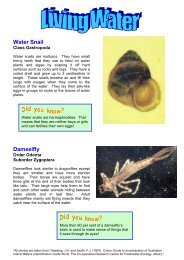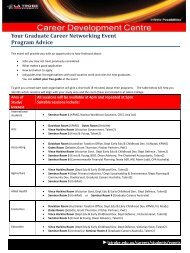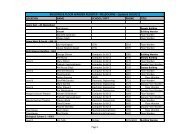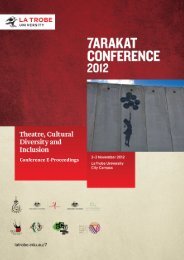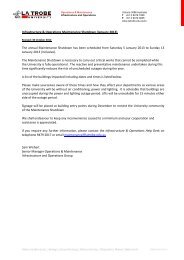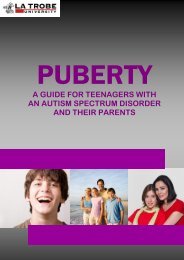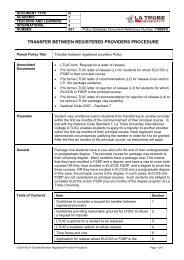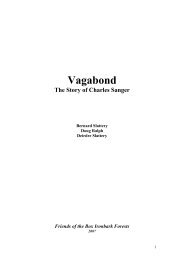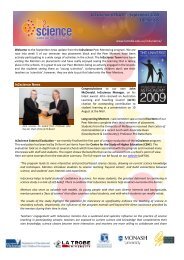Project Report - La Trobe University
Project Report - La Trobe University
Project Report - La Trobe University
You also want an ePaper? Increase the reach of your titles
YUMPU automatically turns print PDFs into web optimized ePapers that Google loves.
The project at a glance<br />
Timeframe<br />
<strong>Project</strong> duration: 5 months<br />
<strong>Project</strong> start: mid February 2009<br />
<strong>Project</strong> end: mid July 2009<br />
Location<br />
The upland-living members of the indigenous<br />
Ichananaw tribe live in the remote, small (104<br />
families, a population of 600-700 inhabitants)<br />
wholly indigenous community of Chananaw<br />
(formally known as ‘Dananao’), located in the<br />
mountains of Kalinga Province, Cordillera<br />
Administrative Region, Northern Luzon. Luzon<br />
is the largest island in the Philippine<br />
archipelago. No road accessible by vehicles<br />
reaches the village and there is no electricity<br />
supply. A cash economy is almost non-existent<br />
within the village since the community practices<br />
subsistence farming. Our project was largely<br />
carried out in both Chananaw and Manila, with<br />
short stints in provincial centers across the<br />
Cordilleras like Baguio, Bontoc and Tabuk.<br />
Key individuals<br />
The Aussies<br />
� Maria Cameron – overall project<br />
manager, educational materials<br />
developer, cultural documenter<br />
� Edwin Wise – educational materials<br />
developer, networking advisor<br />
The Ichananaws<br />
� Agom (Arlene) Dawing – project<br />
supervisor in Chananaw<br />
� Fargwog (Daniel) Aga-id – key tribal<br />
elder involved in the project<br />
� Apalis (Ombin) Abaggoy – became<br />
Maria and Edwin’s unofficial ‘local<br />
counterpart’ as the project unfolded<br />
The Ateneans<br />
� Carmela Oracion – project director at<br />
the Ateneo Center for Educational<br />
Development<br />
� Mai Francia – project officer at Ateneo<br />
Center for Educational Development<br />
Key organizations<br />
� Dananao Elementary School – the<br />
project’s official ‘target beneficiary’ (the<br />
recipient of the educational materials<br />
developed), official host organization for<br />
Maria and Edwin in Chananaw<br />
� Ateneo Center for Educational<br />
Development, Ateneo de Manila<br />
<strong>University</strong> – key organization<br />
partnering with Dananao Elementary<br />
School for the development of<br />
indigenized educational materials<br />
� Philippines Australia Studies Centre,<br />
<strong>La</strong> <strong>Trobe</strong> <strong>University</strong> – supported Maria<br />
and Edwin in their work on the project<br />
by granting each of them Honorary<br />
Research Fellow status<br />
� AusAID-funded Volunteering for<br />
International Development from<br />
Australia – supported Maria and Edwin<br />
as volunteers hosted by Dananao<br />
Elementary School for their work on the<br />
project<br />
� Direct Aid Program, Australian<br />
Government – funded the printing of<br />
the educational materials developed,<br />
from a small grants program managed<br />
by the Australian Embassy in Manila<br />
� Ang Ilustrador ng Kabataan (Ang<br />
INK) – 17 members of the Philippines’<br />
premier children’s book illustrators’<br />
association voluntarily illustrated<br />
several of the educational materials<br />
developed<br />
� Art Angel Printshop – printed all<br />
educational materials developed,<br />
volunteered graphic layout for several<br />
of the educational materials<br />
� Cordillera Studies Center, <strong>University</strong><br />
of the Philippines Baguio – granted<br />
Edwin Research Affiliate status,<br />
provided links and contacts to assist in<br />
the collection of secondary materials



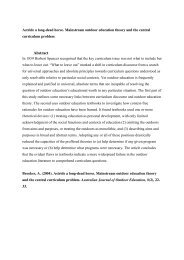
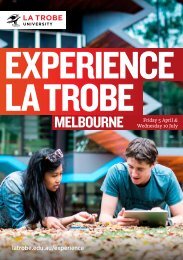
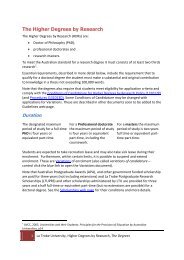
![Ottoman Empire course brochure [PDF 612KB] - La Trobe University](https://img.yumpu.com/12001562/1/184x260/ottoman-empire-course-brochure-pdf-612kb-la-trobe-university.jpg?quality=85)
![Getting Ready to Talk Manual [PDF 315KB] - La Trobe University](https://img.yumpu.com/11430807/1/190x245/getting-ready-to-talk-manual-pdf-315kb-la-trobe-university.jpg?quality=85)
